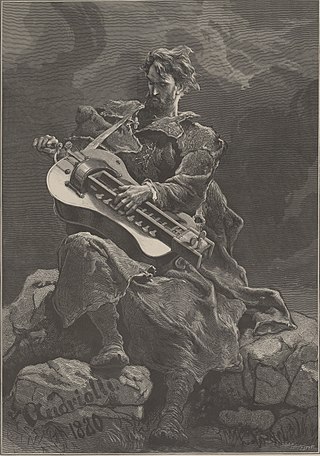Ukrainian music covers diverse and multiple component elements of the music that is found in the Western and Eastern musical civilization. It also has a very strong indigenous Slavic and Christian uniqueness whose elements were used among the areas that surround modern Ukraine.

A bandura is a Ukrainian plucked-string folk-instrument. It combines elements of the zither and lute and, up until the 1940s, was also often called a kobza. Early instruments had 5 to 12 strings and resembled lutes. In the 20th century, the number of strings increased initially to 31 strings (1926), then to 56 strings – 68 strings on modern "concert" instruments (1954).

The kobza, also called bandura is a Ukrainian folk music instrument of the lute family, a relative of the Central European mandora. The term kobza however, has also been applied to a number of other Eastern European instruments distinct from the Ukrainian kobza.
The torban is a Ukrainian musical instrument that combines the features of the Baroque lute with those of the psaltery. The Тorban differs from the more common European bass lute known as the theorbo in that it had additional short unfretted treble strings strung along the treble side of the soundboard.

A Duma is a sung epic poem which originated in Ukraine during the Hetmanate Era in the Sixteenth century. Historically, dumy were performed by itinerant Cossack bards called kobzari, who accompanied themselves on a kobza or a torban, but after the abolition of Hetmanate by the Empress Catherine II of Russia the epic singing became the domain of blind itinerant musicians who retained the kobzar appellation and accompanied their singing by playing a bandura or a relya/lira. Dumas are sung in recitative, in the so-called "duma mode", a variety of the Dorian mode with a raised fourth degree.

A kobzar was an itinerant Ukrainian bard who sang to his own accompaniment, played on a multistringed kobza or bandura.

The lirnyks were itinerant Ukrainian musicians who performed religious, historical and epic songs to the accompaniment of a lira, the Ukrainian version of the hurdy-gurdy.
Kobzarskyi Tsekh, literally "Kobzar guild", is an organization of kobzars, which have existed since the 17th century in Ukraine.

The Kyiv Bandurist Capella is a male vocal-instrumental ensemble that accompanies its singing with the playing of the multi-stringed Ukrainian folk instrument known as the bandura.
Kobzarstvo in the wider definition, is the art and related culture of singing to the accompaniment of the Ukrainian plucked string instruments bandura and kobza, as well as the Ukrainian hurdy-gurdy, which is called lira.

Kostantyn Heorhiovych Novytsky, better known as Kost' Novytsky is a Merited Artist of Ukraine and one of the more influential bandurists in Kyiv today.

The Ukrainian Bandurist Chorus is a semi-professional male choir which accompanies itself with the multi-stringed Ukrainian ethnic instrument known as the bandura. It traces its roots to Ukraine in 1918 and has been based in the USA since 1949.

Vasyl Kostovych Yemetz was a Ukrainian bandurist. He was founder and initial director of the Kobzar Choir in 1918 - the direct protégé of the Kyiv Bandurist Capella and the Ukrainian Bandurist Chorus.
Serhiy Vasylievych Bashtan was a professor of bandura at the Kiev Conservatory.
Andriy Fedorovych Omelchenko was a Ukrainian virtuoso bandura soloist and composer. He taught bandura at the Ukrainian Institute of Culture and performed outside the Soviet Union.
A Kuban bandurist is a person who plays the Ukrainian plucked string instrument known as the bandura, who is from Kuban, a geographic region of southern Russia surrounding the Kuban River.

Yuriy Fedynsky is a Ukrainian-American composer, musician, singer-songwriter, producer, bandleader, luthier, cultural activist, and pedagogue. Fedynsky performs on kobza, torban, and traditional bandura.

Paul Stepanovych Konoplenko-Zaprozhetz was a Ukrainian Canadian author and kobza player.

Mykola Petrovych Budnyk was a luthier and traditional performer in the Kobzar tradition. He was active in authentic construction and recreation of historic folk instruments, and involved in the movement for authentic performаnce practice on Ukrainian folk instruments. Budnyk was also known as a painter and poet. He was born in 1954 in Skolobiv, near Khoroshiv, Zhytomyr region, and died January 16, 2001, in Irpin', Kyiv region.
Kobza is a vocal and instrumental ensemble of Ukraine from the 1970s and 1980s. VIA "Kobza" was the first of the bands of the former Soviet Union to go on a commercial tour on the American continent (1982). The original band leader was Oleksandr Zuev. One of the songwriters and current bandleader is Yevhen Kovalenko.












